[English] 日本語
 Yorodumi
Yorodumi- EMDB-31308: Structure of the human GluN1-GluN2A NMDA receptor in complex with... -
+ Open data
Open data
- Basic information
Basic information
| Entry | Database: EMDB / ID: EMD-31308 | ||||||||||||||||||||||||||||||
|---|---|---|---|---|---|---|---|---|---|---|---|---|---|---|---|---|---|---|---|---|---|---|---|---|---|---|---|---|---|---|---|
| Title | Structure of the human GluN1-GluN2A NMDA receptor in complex with S-ketamine, glycine and glutamate | ||||||||||||||||||||||||||||||
 Map data Map data | |||||||||||||||||||||||||||||||
 Sample Sample |
| ||||||||||||||||||||||||||||||
 Keywords Keywords | NMDA receptor / ketamine / enantiomer / rapid antidepressant / cryo-EM structure / MEMBRANE PROTEIN | ||||||||||||||||||||||||||||||
| Function / homology |  Function and homology information Function and homology informationglycine-gated cation channel activity / excitatory chemical synaptic transmission / directional locomotion / Synaptic adhesion-like molecules / protein localization to postsynaptic membrane / serotonin metabolic process / response to glycine / propylene metabolic process / sleep / Assembly and cell surface presentation of NMDA receptors ...glycine-gated cation channel activity / excitatory chemical synaptic transmission / directional locomotion / Synaptic adhesion-like molecules / protein localization to postsynaptic membrane / serotonin metabolic process / response to glycine / propylene metabolic process / sleep / Assembly and cell surface presentation of NMDA receptors / regulation of monoatomic cation transmembrane transport / NMDA glutamate receptor activity / Neurexins and neuroligins / NMDA selective glutamate receptor complex / glutamate binding / ligand-gated sodium channel activity / neurotransmitter receptor complex / glutamate receptor signaling pathway / calcium ion transmembrane import into cytosol / protein heterotetramerization / glycine binding / startle response / positive regulation of reactive oxygen species biosynthetic process / dopamine metabolic process / monoatomic cation transmembrane transport / Negative regulation of NMDA receptor-mediated neuronal transmission / Unblocking of NMDA receptors, glutamate binding and activation / positive regulation of calcium ion transport into cytosol / Long-term potentiation / excitatory synapse / monoatomic ion channel complex / monoatomic cation transport / regulation of neuronal synaptic plasticity / positive regulation of excitatory postsynaptic potential / synaptic cleft / positive regulation of synaptic transmission, glutamatergic / calcium ion homeostasis / MECP2 regulates neuronal receptors and channels / glutamate-gated calcium ion channel activity / neurogenesis / EPHB-mediated forward signaling / sensory perception of pain / ionotropic glutamate receptor signaling pathway / Ras activation upon Ca2+ influx through NMDA receptor / sodium ion transmembrane transport / synaptic membrane / response to amphetamine / cytoplasmic vesicle membrane / regulation of membrane potential / transmitter-gated monoatomic ion channel activity involved in regulation of postsynaptic membrane potential / synaptic transmission, glutamatergic / excitatory postsynaptic potential / protein catabolic process / postsynaptic density membrane / brain development / regulation of synaptic plasticity / visual learning / negative regulation of protein catabolic process / calcium ion transmembrane transport / response to wounding / memory / long-term synaptic potentiation / terminal bouton / synaptic vesicle / signaling receptor activity / amyloid-beta binding / presynaptic membrane / RAF/MAP kinase cascade / response to ethanol / dendritic spine / chemical synaptic transmission / postsynaptic membrane / learning or memory / calmodulin binding / neuron projection / postsynaptic density / positive regulation of apoptotic process / response to xenobiotic stimulus / calcium ion binding / synapse / dendrite / endoplasmic reticulum membrane / protein-containing complex binding / glutamatergic synapse / cell surface / positive regulation of transcription by RNA polymerase II / zinc ion binding / plasma membrane / cytoplasm Similarity search - Function | ||||||||||||||||||||||||||||||
| Biological species |  Homo sapiens (human) Homo sapiens (human) | ||||||||||||||||||||||||||||||
| Method | single particle reconstruction / cryo EM / Resolution: 3.5 Å | ||||||||||||||||||||||||||||||
 Authors Authors | Zhang Y / Zhang T / Zhu S | ||||||||||||||||||||||||||||||
| Funding support |  China, 9 items China, 9 items
| ||||||||||||||||||||||||||||||
 Citation Citation |  Journal: Nature / Year: 2021 Journal: Nature / Year: 2021Title: Structural basis of ketamine action on human NMDA receptors. Authors: Youyi Zhang / Fei Ye / Tongtong Zhang / Shiyun Lv / Liping Zhou / Daohai Du / He Lin / Fei Guo / Cheng Luo / Shujia Zhu /  Abstract: Ketamine is a non-competitive channel blocker of N-methyl-D-aspartate (NMDA) receptors. A single sub-anaesthetic dose of ketamine produces rapid (within hours) and long-lasting antidepressant effects ...Ketamine is a non-competitive channel blocker of N-methyl-D-aspartate (NMDA) receptors. A single sub-anaesthetic dose of ketamine produces rapid (within hours) and long-lasting antidepressant effects in patients who are resistant to other antidepressants. Ketamine is a racemic mixture of S- and R-ketamine enantiomers, with S-ketamine isomer being the more active antidepressant. Here we describe the cryo-electron microscope structures of human GluN1-GluN2A and GluN1-GluN2B NMDA receptors in complex with S-ketamine, glycine and glutamate. Both electron density maps uncovered the binding pocket for S-ketamine in the central vestibule between the channel gate and selectivity filter. Molecular dynamics simulation showed that S-ketamine moves between two distinct locations within the binding pocket. Two amino acids-leucine 642 on GluN2A (homologous to leucine 643 on GluN2B) and asparagine 616 on GluN1-were identified as key residues that form hydrophobic and hydrogen-bond interactions with ketamine, and mutations at these residues reduced the potency of ketamine in blocking NMDA receptor channel activity. These findings show structurally how ketamine binds to and acts on human NMDA receptors, and pave the way for the future development of ketamine-based antidepressants. | ||||||||||||||||||||||||||||||
| History |
|
- Structure visualization
Structure visualization
| Movie |
 Movie viewer Movie viewer |
|---|---|
| Structure viewer | EM map:  SurfView SurfView Molmil Molmil Jmol/JSmol Jmol/JSmol |
| Supplemental images |
- Downloads & links
Downloads & links
-EMDB archive
| Map data |  emd_31308.map.gz emd_31308.map.gz | 9.9 MB |  EMDB map data format EMDB map data format | |
|---|---|---|---|---|
| Header (meta data) |  emd-31308-v30.xml emd-31308-v30.xml emd-31308.xml emd-31308.xml | 16.2 KB 16.2 KB | Display Display |  EMDB header EMDB header |
| FSC (resolution estimation) |  emd_31308_fsc.xml emd_31308_fsc.xml | 10.7 KB | Display |  FSC data file FSC data file |
| Images |  emd_31308.png emd_31308.png | 128.9 KB | ||
| Filedesc metadata |  emd-31308.cif.gz emd-31308.cif.gz | 6.6 KB | ||
| Archive directory |  http://ftp.pdbj.org/pub/emdb/structures/EMD-31308 http://ftp.pdbj.org/pub/emdb/structures/EMD-31308 ftp://ftp.pdbj.org/pub/emdb/structures/EMD-31308 ftp://ftp.pdbj.org/pub/emdb/structures/EMD-31308 | HTTPS FTP |
-Validation report
| Summary document |  emd_31308_validation.pdf.gz emd_31308_validation.pdf.gz | 426.6 KB | Display |  EMDB validaton report EMDB validaton report |
|---|---|---|---|---|
| Full document |  emd_31308_full_validation.pdf.gz emd_31308_full_validation.pdf.gz | 426.2 KB | Display | |
| Data in XML |  emd_31308_validation.xml.gz emd_31308_validation.xml.gz | 11.5 KB | Display | |
| Data in CIF |  emd_31308_validation.cif.gz emd_31308_validation.cif.gz | 15.3 KB | Display | |
| Arichive directory |  https://ftp.pdbj.org/pub/emdb/validation_reports/EMD-31308 https://ftp.pdbj.org/pub/emdb/validation_reports/EMD-31308 ftp://ftp.pdbj.org/pub/emdb/validation_reports/EMD-31308 ftp://ftp.pdbj.org/pub/emdb/validation_reports/EMD-31308 | HTTPS FTP |
-Related structure data
| Related structure data |  7eu7MC  7eu8C M: atomic model generated by this map C: citing same article ( |
|---|---|
| Similar structure data |
- Links
Links
| EMDB pages |  EMDB (EBI/PDBe) / EMDB (EBI/PDBe) /  EMDataResource EMDataResource |
|---|---|
| Related items in Molecule of the Month |
- Map
Map
| File |  Download / File: emd_31308.map.gz / Format: CCP4 / Size: 103 MB / Type: IMAGE STORED AS FLOATING POINT NUMBER (4 BYTES) Download / File: emd_31308.map.gz / Format: CCP4 / Size: 103 MB / Type: IMAGE STORED AS FLOATING POINT NUMBER (4 BYTES) | ||||||||||||||||||||||||||||||||||||||||||||||||||||||||||||||||||||
|---|---|---|---|---|---|---|---|---|---|---|---|---|---|---|---|---|---|---|---|---|---|---|---|---|---|---|---|---|---|---|---|---|---|---|---|---|---|---|---|---|---|---|---|---|---|---|---|---|---|---|---|---|---|---|---|---|---|---|---|---|---|---|---|---|---|---|---|---|---|
| Projections & slices | Image control
Images are generated by Spider. | ||||||||||||||||||||||||||||||||||||||||||||||||||||||||||||||||||||
| Voxel size | X=Y=Z: 0.83 Å | ||||||||||||||||||||||||||||||||||||||||||||||||||||||||||||||||||||
| Density |
| ||||||||||||||||||||||||||||||||||||||||||||||||||||||||||||||||||||
| Symmetry | Space group: 1 | ||||||||||||||||||||||||||||||||||||||||||||||||||||||||||||||||||||
| Details | EMDB XML:
CCP4 map header:
| ||||||||||||||||||||||||||||||||||||||||||||||||||||||||||||||||||||
-Supplemental data
- Sample components
Sample components
-Entire : Structure of the human GluN1/GluN2A NMDA receptor in complex with...
| Entire | Name: Structure of the human GluN1/GluN2A NMDA receptor in complex with S-ketamine, glycine and glutamate, at pH 8.0 |
|---|---|
| Components |
|
-Supramolecule #1: Structure of the human GluN1/GluN2A NMDA receptor in complex with...
| Supramolecule | Name: Structure of the human GluN1/GluN2A NMDA receptor in complex with S-ketamine, glycine and glutamate, at pH 8.0 type: complex / ID: 1 / Parent: 0 / Macromolecule list: #1-#2 |
|---|---|
| Source (natural) | Organism:  Homo sapiens (human) Homo sapiens (human) |
-Supramolecule #2: human GluN1
| Supramolecule | Name: human GluN1 / type: complex / ID: 2 / Parent: 1 / Macromolecule list: #1 |
|---|---|
| Source (natural) | Organism:  Homo sapiens (human) Homo sapiens (human) |
-Supramolecule #3: human GluN2
| Supramolecule | Name: human GluN2 / type: complex / ID: 3 / Parent: 1 / Macromolecule list: #2 |
|---|
-Macromolecule #1: Glutamate receptor ionotropic, NMDA 1
| Macromolecule | Name: Glutamate receptor ionotropic, NMDA 1 / type: protein_or_peptide / ID: 1 / Number of copies: 2 / Enantiomer: LEVO |
|---|---|
| Source (natural) | Organism:  Homo sapiens (human) Homo sapiens (human) |
| Molecular weight | Theoretical: 95.236078 KDa |
| Recombinant expression | Organism:  Homo sapiens (human) Homo sapiens (human) |
| Sequence | String: MSTMRLLTLA LLFSCSVARA ACDPKIVNIG AVLSTRKHEQ MFREAVNQAN KRHGSWKIQL NATSVTHKPN AIQMALSVCE DLISSQVYA ILVSHPPTPN DHFTPTPVSY TAGFYRIPVL GLTTRMSIYS DKSIHLSFLR TVPPYSHQSS VWFEMMRVYS W NHIILLVS ...String: MSTMRLLTLA LLFSCSVARA ACDPKIVNIG AVLSTRKHEQ MFREAVNQAN KRHGSWKIQL NATSVTHKPN AIQMALSVCE DLISSQVYA ILVSHPPTPN DHFTPTPVSY TAGFYRIPVL GLTTRMSIYS DKSIHLSFLR TVPPYSHQSS VWFEMMRVYS W NHIILLVS DDHEGRAAQK RLETLLEERE SKAEKVLQFD PGTKNVTALL MEAKELEARV IILSASEDDA ATVYRAAAML NM TGSGYVW LVGEREISGN ALRYAPDGIL GLQLINGKNE SAHISDAVGV VAQAVHELLE KENITDPPRG CVGNTNIWKT GPL FKRVLM SSKYADGVTG RVEFNEDGDR KFANYSIMNL QNRKLVQVGI YNGTHVIPND RKIIWPGGET EKPRGYQMST RLKI VTIHQ EPFVYVKPTL SDGTCKEEFT VNGDPVKKVI CTGPNDTSPG SPRHTVPQCC YGFCIDLLIK LARTMNFTYE VHLVA DGKF GTQERVNNSN KKEWNGMMGE LLSGQADMIV APLTINNERA QYIEFSKPFK YQGLTILVKK EIPRSTLDSF MQPFQS TLW LLVGLSVHVV AVMLYLLDRF SPFGRFKVNS EEEEEDALTL SSAMWFSWGV LLNSGIGEGA PRSFSARILG MVWAGFA MI IVASYTANLA AFLVLDRPEE RITGINDPRL RNPSDKFIYA TVKQSSVDIY FRRQVELSTM YRHMEKHNYE SAAEAIQA V RDNKLHAFIW DSAVLEFEAS QKCDLVTTGE LFFRSGFGIG MRKDSPWKQN VSLSILKSHE NGFMEDLDKT WVRYQECDS RSNAPATLTF ENMAGVFMLV AGGIVAGIFL IFIEIAYKRH KDARRKQ UniProtKB: Glutamate receptor ionotropic, NMDA 1 |
-Macromolecule #2: Glutamate receptor ionotropic, NMDA 2A
| Macromolecule | Name: Glutamate receptor ionotropic, NMDA 2A / type: protein_or_peptide / ID: 2 / Number of copies: 2 / Enantiomer: LEVO |
|---|---|
| Source (natural) | Organism:  Homo sapiens (human) Homo sapiens (human) |
| Molecular weight | Theoretical: 94.136016 KDa |
| Recombinant expression | Organism:  Homo sapiens (human) Homo sapiens (human) |
| Sequence | String: MGRVGYWTLL VLPALLVWRG PAPSAAAEKG PPALNIAVML GHSHDVTERE LRTLWGPEQA AGLPLDVNVV ALLMNRTDPK SLITHVCDL MSGARIHGLV FGDDTDQEAV AQMLDFISSH TFVPILGIHG GASMIMADKD PTSTFFQFGA SIQQQATVML K IMQDYDWH ...String: MGRVGYWTLL VLPALLVWRG PAPSAAAEKG PPALNIAVML GHSHDVTERE LRTLWGPEQA AGLPLDVNVV ALLMNRTDPK SLITHVCDL MSGARIHGLV FGDDTDQEAV AQMLDFISSH TFVPILGIHG GASMIMADKD PTSTFFQFGA SIQQQATVML K IMQDYDWH VFSLVTTIFP GYREFISFVK TTVDNSFVGW DMQNVITLDT SFEDAKTQVQ LKKIHSSVIL LYCSKDEAVL IL SEARSLG LTGYDFFWIV PSLVSGNTEL IPKEFPSGLI SVSYDDWDYS LEARVRDGIG ILTTAASSML EKFSYIPEAK ASC YGQMER PEVPMHTLHP FMVNVTWDGK DLSFTEEGYQ VHPRLVVIVL NKDREWEKVG KWENHTLSLR HAVWPRYKSF SDCE PDDNH LSIVTLEEAP FVIVEDIDPL TETCVRNTVP CRKFVKINNS TNEGMNVKKC CKGFCIDILK KLSRTVKFTY DLYLV TNGK HGKKVNNVWN GMIGEVVYQR AVMAVGSLTI NEERSEVVDF SVPFVETGIS VMVSRSNGTV SPSAFLEPFS ASVWVM MFV MLLIVSAIAV FVFEYFSPVG YNRNLAKGKA PHGPSFTIGK AIWLLWGLVF NNSVPVQNPK GTTSKIMVSV WAFFAVI FL ASYTANLAAF MIQEEFVDQV TGLSDKKFQR PHDYSPPFRF GTVPNGSTER NIRNNYPYMH QYMTKFNQKG VEDALVSL K TGKLDAFIYD AAVLNYKAGR DEGCKLVTIG SGYIFATTGY GIALQKGSPW KRQIDLALLQ FVGDGEMEEL ETLWLTGIC HNEKNEVMSS QLDIDNMAGV FYMLAAAMAL SLITFIWEHL F UniProtKB: Glutamate receptor ionotropic, NMDA 2A |
-Macromolecule #3: 2-acetamido-2-deoxy-beta-D-glucopyranose
| Macromolecule | Name: 2-acetamido-2-deoxy-beta-D-glucopyranose / type: ligand / ID: 3 / Number of copies: 24 / Formula: NAG |
|---|---|
| Molecular weight | Theoretical: 221.208 Da |
| Chemical component information |  ChemComp-NAG: |
-Macromolecule #4: GLYCINE
| Macromolecule | Name: GLYCINE / type: ligand / ID: 4 / Number of copies: 2 / Formula: GLY |
|---|---|
| Molecular weight | Theoretical: 75.067 Da |
| Chemical component information | 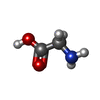 ChemComp-GLY: |
-Macromolecule #5: GLUTAMIC ACID
| Macromolecule | Name: GLUTAMIC ACID / type: ligand / ID: 5 / Number of copies: 2 / Formula: GLU |
|---|---|
| Molecular weight | Theoretical: 147.129 Da |
| Chemical component information | 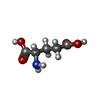 ChemComp-GLU: |
-Macromolecule #6: (2~{S})-2-(2-chlorophenyl)-2-(methylamino)cyclohexan-1-one
| Macromolecule | Name: (2~{S})-2-(2-chlorophenyl)-2-(methylamino)cyclohexan-1-one type: ligand / ID: 6 / Number of copies: 1 / Formula: JC9 |
|---|---|
| Molecular weight | Theoretical: 237.725 Da |
| Chemical component information | 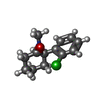 ChemComp-JC9: |
-Experimental details
-Structure determination
| Method | cryo EM |
|---|---|
 Processing Processing | single particle reconstruction |
| Aggregation state | particle |
- Sample preparation
Sample preparation
| Buffer | pH: 8 |
|---|---|
| Vitrification | Cryogen name: ETHANE |
- Electron microscopy
Electron microscopy
| Microscope | FEI TITAN KRIOS |
|---|---|
| Image recording | Film or detector model: GATAN K3 (6k x 4k) / Average electron dose: 60.0 e/Å2 |
| Electron beam | Acceleration voltage: 300 kV / Electron source:  FIELD EMISSION GUN FIELD EMISSION GUN |
| Electron optics | Illumination mode: OTHER / Imaging mode: BRIGHT FIELD |
| Experimental equipment |  Model: Titan Krios / Image courtesy: FEI Company |
 Movie
Movie Controller
Controller




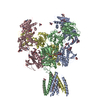



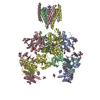
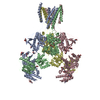
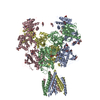















 Z (Sec.)
Z (Sec.) Y (Row.)
Y (Row.) X (Col.)
X (Col.)























